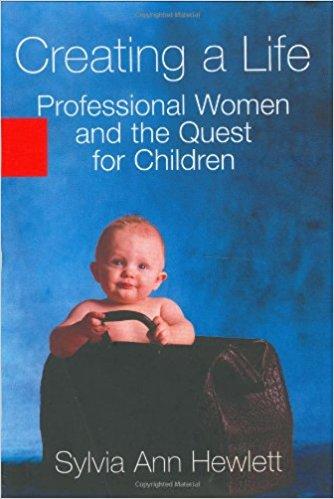Creating a Life Summary
5 min read ⌚
 Professional Women and the Quest for Children
Professional Women and the Quest for Children
You have heard it many times: women have turned away from their families and focused on their careers.
But what are the consequences of that choice? And what can women do about those consequences?
Read on to find out.
Who Should Read “Creating a Life”? and Why?
“Creating a Life” had a controversial start in the U.S. It got known as the book who condemned career women as waiting too long to start families.
However, aside from the talks that surrounded it, the author’s opinion was not correctly interpreted.
Hewlett does not attack career women: she is one herself. Instead, inspired by her own experience connected to fertility problems, she studies the reasons why so many successful women stay alone all their lives and never have kids.
We recommend this book to all career women, as well as their partners. Do not listen to the rumors. Read it yourself and decide whether its information is worth taking into consideration or not.
About Sylvia Ann Hewlett
 Sylvia Ann Hewett is an author, an economist and the founder and chair of the National Parenting Association.
Sylvia Ann Hewett is an author, an economist and the founder and chair of the National Parenting Association.
“Creating a Life Summary”
Society is approaching a state in which there are many successful women out there, but not enough children.
The analysis offered in “Creating a Life” is based on a series of interviews with women in the fifth decade of their lives, who successfully broke the gender barrier and thrived in careers dominated by men.
An interesting fact was that many of the women interviewed were childless, which became this book’s primary goal: to show how women’s need and to wish for children has been pushed out by career pursuits and needy partners.
Childlessness is a problem many successful women share.
Yes, you read right. A problem.
The failure to have children comes from a disbalance between the personal and professional life.
In fact, women who want to build a career do not have much time to have children, since by the time they reach 35 they already experience fertility problems.
The author of this book was herself one of those women who had a hard time getting pregnant, and finally, she had her first child at the age of 51.
Until she got it, she has gone through several miscarriages which resulted from overworking herself as well as to age.
The author is not saying that women should stop pursuing their career goals, but that they also need to put an equal amount of importance on finding a partner during their 20s and early 30s, as they put on their careers.
The private life is just like the career – it won’t take care of itself unless you put in some effort.
What society needs to give women are jobs with fewer hours, and careers that allow for interruptions.
However, at the moment such options are not widely available.
Now, let’s get one thing straight – women are not the problem. Society is.
Even men feel intimidated to be in a relationship with a highly successful career woman. They see such women as competitors and not as the emotionally supportive partners they would want for themselves.
Male egos are highly dependent on support, so such a situation is logical.
Men do not want to have a peer; they want a woman who is young, sexy, and who makes them feel superior.
Many successful women out there can have children if they decide to, even if it means being single mothers. However, most of them are forced to choose between having a family or having a career.
Some drop their careers altogether, and others are always in the process of reinventing their careers or starting new ones to find better support for their childbearing.
As you can already notice, women lack the social support they need that would enable them to keep a healthy balance between their families and career.
Key Lessons from “Creating a Life”
1. Solving the Childlessness Problem
2. Facts About Women and the Wage Gap
3. Perceptions and Misperceptions
Solving the Childlessness Problem
-
- Stay married in a loving relationship
-
- The creation of a time bank of paid parenting leave
-
- Restructured retirement plans and an elimination of the penalty for career interruptions
-
- An option for a career break with up to three years of unpaid, job-protected leave;
-
- The creation of high-level jobs with reduced hours and a reduced workload;
- Tax breaks for re-entry into the workforce.
Facts About Women and the Wage Gap
The wage gap has narrowed in general, but the following points are still valid:
-
- Women in the highest salary are just 62% of their male counterparts’ wages, even with more women in managerial occupations.
-
- The responsibility for a family is a significant cause of this discrepancy.
-
- Childbearing interrupts and narrows a woman’s career potential.
- The earning possibilities decrease as women age: women age 25 to 29 earn 87% of what their male counterparts do. Once women enter their prime childbearing years, on the other hand, they fall behind.
Perceptions and Misperceptions
After they enter the third decade, women who want to have children are limited by two challenges: the problem of infertility and the shortage of males.
Indeed, at the time of doing it – postponing family life seems logical for a woman who just starts a promising career.
However, as they grow older, women have a harder time finding a suitable mate, since men are the object of attention not only of accomplished women of their age, but of younger, less accomplished rivals as well.
Like this summary? We’d Like to invite you to download our free 12 min app, for more amazing summaries and audiobooks.
“Creating a Life” Quotes
Women can be playwrights, presidential candidates, and CEOs, but increasingly, they cannot be mothers. Share on X Nowadays, the rule of thumb seems to be that the more successful the woman, the less likely it is she will find a husband or bear children. For men the reverse is true. Share on X The more successful the man, the more likely he is to be married with children. Share on X If you are a career woman who has had the tenacity to nurture both a career and a long-term loving relationship, you might well be on the wrong side of 35 before you have the time to draw breath and contemplate having a child - exactly… Share on X What high-achieving women need are two things that are not yet readily available: reduced-hour jobs and careers that can be interrupted. Share on XOur Critical Review
Indeed, this book’s summary may sound controversial, especially since nowadays women empowerment is a rule of thumb.
However, it tries to do precisely that – to cast a spotlight on the issue of childless women and try to make society see how it can help career women become mothers.
The author has a well-reasoned theory on why women stay without families, and her logic is tempting and worth taking into consideration.
Emir is the Head of Marketing at 12min. In his spare time, he loves to meditate and play soccer.


 Professional Women and the Quest for Children
Professional Women and the Quest for Children




